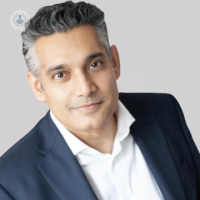The benefits of EPSiT for the treatment of pilonidal sinuses
Written in association with:As we reach puberty, our bodies begin to exhibit exciting changes. But sometimes, these changes can work against us. Consultant colorectal surgeon Mr Nikhil Pawa diffuses the shame and mystery around pilonidal sinuses and provides insight on one of the best treatments available for pilonidal sinus disease — one safe for adults and adolescents alike.

What is a pilonidal sinus and what is pilonidal sinus disease?
A pilonidal sinus is a hole or lesion that can occur at the top of the cleft that runs between the buttocks at the tailbone (the coccyx), and is caused by a plugging of ingrown hair follicles or excessive friction due to the hair rubbing against the skin. This irritation then develops into a tract in which bacteria, hair, dead skin cells, and other debris can get trapped inside and worsen the condition of the area, leading to infection, discharge, or even an abscess. There can be more than one inflamed sinus in the area, and the sensation can range from mild discomfort to sharp and constant pain. They can occur in anyone, but those who have thicker, coarser hair most common in men from the ages of puberty, when the body hair begins to thicken, to around the age of 40. will be more likely to be affected; thus, pilonidal disease is when these sinuses are chronic. The condition can be exacerbated by those who put pressure on that area due to lifestyle — such as horseback riding, cycling, or remaining sedentary for long periods — or due to genetic traits such as excessive sweating or natural hairiness.
What is EPSiT and how is it used to treat a pilonidal sinus?
There are several different methods for addressing pilonidal sinuses, from improving hygiene routines to laser hair removal, but for those with pilonidal sinus disease, endoscopic pilonidal sinus treatment (EPSiT) is a minimally invasive surgical procedure that can be performed under a general anaesthetic. A small camera (the endoscope) is used to examine the area carefully whilst the surgeon cleans out the irritant material from the area, and the infected or necrotic tissue is then removed through cauterisation. No extraneous incisions are made, and the wound requires light dressing afterward. The entire procedure is short and patients should be able to go home within a few hours.
Can adolescents with pilonidal sinuses also get an EPSiT?
The EPSiT procedure is one of the best options for adolescents suffering from pilonidal sinus disease because as they develop in height and weight, the skin around their tailbones will shift and warp. Since their bodies are still developing, it’s essential to use a precise technique that minimises scarring and damage to surrounding tissue. There are very low chances of complications like infections or excessive scarring post-surgery. Other patients report nominal pain during the convalescence period. This procedure also acts as a preventative for future reoccurrence of more pilonidal sinuses.
What are the benefits of EPSiT?
This procedure is preferable due to its minimal discomfort and fast recovery time — in most cases, there should not even be a scar when healed entirely. Patients can return to work or school within a week, sometimes as soon as three days after the surgery. The aftercare advice varies and it is always best to consult with your doctor, but on average the wound should be entirely healed in about a month after the procedure.
Additionally, as the procedure has such a short recovery time, adolescents can resume their schooling, activities, or social lives without great interruption. There are risks to be had in any surgical procedure, of course, but the satisfaction rate for EPSiT patients is higher than that of those who underwent more invasive or major surgeries. Parents and patients should discuss these risks with the surgeon to understand the best course of action for individual cases.
Mr Nikhil Pawa is a general surgeon in London and is one of the few specialists in the area offering the EPSiT procedure for adolescents. To consult with him, you can check out his Top Doctors profile.


